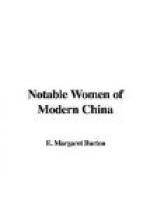His health did not improve as rapidly as the doctor thought it should; and upon making careful inquiries she learned that it was because the small amount of money which it was possible for him to earn, was not sufficient to provide him with the nourishing food he needed. She at once gave him some money, telling him to buy the sort of food which would build-up his strength, and not to tell any one that he had been given this help. But this was altogether too much to ask of the grateful old man, and “he went out and began to publish it.” The family who had sent him to the doctor were much touched by this fresh evidence of her kindness, and thereafter they sent their son with the old man to the morning services each day, saying: “The Christian doctor is so good and kind. She has not only treated this poor man free of charge but has helped him with money. Surely this religion must be good.”
Often patients come from far away villages to enter the hospital. One young girl from a town many miles up the Min River, who became a happy, eager Christian in the hospital, went home with the hope of coming back to study in the Girls’ Boarding School the next year. She was very eager to tell the people of her village, in the meantime, of the glad truths she had learned. “I will be the only Christian in the village,” she said. “How I wish Dr. Hue and Lau Sing-sang Moing (the Bible woman) would come and tell my people about the new religion. I will tell them all I know, but I don’t know very much.” One case is related of an old woman with double cataracts, whose son brought her on a wheelbarrow a distance of several hundred miles to consult Dr. Hue. The doctor performed a successful operation, restoring the woman’s sight, and thereby earning the title of “The Miracle Lady.”
A large work is done every year in the dispensary, where Dr. Hue receives patients each morning. This work has grown from 1,837 cases the first year to 24,091 in 1910, and has made literally thousands of friends for the doctor and her work. When she planned to erect the little building in which she lives on Black Rock Hill many people told her that they were sure the priests, especially those of the Black Rock Hill temple, would strongly object to the erection of a mission building on that site, which was considered a particularly sacred one. But Dr. Hue felt no anxiety in regard to that, for the priests had been coming to the dispensary for treatment for some months previous to the time of beginning the building. “Some have come from Singapore monastery,” she wrote, “others from Kushan, still others from those in our own city. Thank God that their illnesses were quickly healed.”
She tells of one of the Singapore priests who was so grateful to be well again that he came to the hospital one morning, dressed as for some festival occasion, and bringing with him two boxes of cakes and two Chinese scrolls, the Chinese characters of which he had himself written. These he presented to Dr. Hue with his lowest bow, saying, “If I had not come to you and taken your medicine I would have been dead, or at least I would not be able to go back to Singapore.” Many priests even came to the morning services and listened attentively to what was said there.




